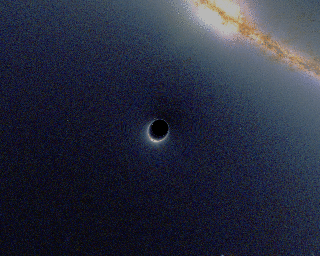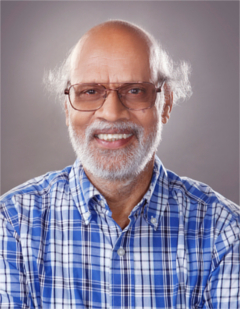
The Standard Model of particle physics is the theory describing three of the four known fundamental forces in the universe and classifying all known elementary particles. It was developed in stages throughout the latter half of the 20th century, through the work of many scientists worldwide, with the current formulation being finalized in the mid-1970s upon experimental confirmation of the existence of quarks. Since then, proof of the top quark (1995), the tau neutrino (2000), and the Higgs boson (2012) have added further credence to the Standard Model. In addition, the Standard Model has predicted various properties of weak neutral currents and the W and Z bosons with great accuracy.
String field theory (SFT) is a formalism in string theory in which the dynamics of relativistic strings is reformulated in the language of quantum field theory. This is accomplished at the level of perturbation theory by finding a collection of vertices for joining and splitting strings, as well as string propagators, that give a Feynman diagram-like expansion for string scattering amplitudes. In most string field theories, this expansion is encoded by a classical action found by second-quantizing the free string and adding interaction terms. As is usually the case in second quantization, a classical field configuration of the second-quantized theory is given by a wave function in the original theory. In the case of string field theory, this implies that a classical configuration, usually called the string field, is given by an element of the free string Fock space.
The Chern–Simons theory is a 3-dimensional topological quantum field theory of Schwarz type developed by Edward Witten. It was discovered first by mathematical physicist Albert Schwarz. It is named after mathematicians Shiing-Shen Chern and James Harris Simons, who introduced the Chern–Simons 3-form. In the Chern–Simons theory, the action is proportional to the integral of the Chern–Simons 3-form.

In particle physics, a tetraquark is an exotic meson composed of four valence quarks. A tetraquark state has long been suspected to be allowed by quantum chromodynamics, the modern theory of strong interactions. A tetraquark state is an example of an exotic hadron which lies outside the conventional quark model classification. A number of different types of tetraquark have been observed.

In physics, lattice gauge theory is the study of gauge theories on a spacetime that has been discretized into a lattice.
In theoretical physics, a Nielsen–Olesen vortex is a point-like object localized in two spatial dimensions or, equivalently, a classical solution of field theory with the same property. This particular solution occurs if the configuration space of scalar fields contains non-contractible circles. A circle surrounding the vortex at infinity may be "wrapped" once on the other circle in the configuration space. A configuration with this non-trivial topological property is called the Nielsen–Olesen vortex, after Holger Bech Nielsen and Poul Olesen (1973). The solution is formally identical to the solution of Quantum vortex in superconductor.
An exotic star is a hypothetical compact star composed of exotic matter, and balanced against gravitational collapse by degeneracy pressure or other quantum properties.

In physics, canonical quantum gravity is an attempt to quantize the canonical formulation of general relativity. It is a Hamiltonian formulation of Einstein's general theory of relativity. The basic theory was outlined by Bryce DeWitt in a seminal 1967 paper, and based on earlier work by Peter G. Bergmann using the so-called canonical quantization techniques for constrained Hamiltonian systems invented by Paul Dirac. Dirac's approach allows the quantization of systems that include gauge symmetries using Hamiltonian techniques in a fixed gauge choice. Newer approaches based in part on the work of DeWitt and Dirac include the Hartle–Hawking state, Regge calculus, the Wheeler–DeWitt equation and loop quantum gravity.
In theoretical physics, the BRST formalism, or BRST quantization denotes a relatively rigorous mathematical approach to quantizing a field theory with a gauge symmetry. Quantization rules in earlier quantum field theory (QFT) frameworks resembled "prescriptions" or "heuristics" more than proofs, especially in non-abelian QFT, where the use of "ghost fields" with superficially bizarre properties is almost unavoidable for technical reasons related to renormalization and anomaly cancellation.

The light-front quantization of quantum field theories provides a useful alternative to ordinary equal-time quantization. In particular, it can lead to a relativistic description of bound systems in terms of quantum-mechanical wave functions. The quantization is based on the choice of light-front coordinates, where plays the role of time and the corresponding spatial coordinate is . Here, is the ordinary time, is one Cartesian coordinate, and is the speed of light. The other two Cartesian coordinates, and , are untouched and often called transverse or perpendicular, denoted by symbols of the type . The choice of the frame of reference where the time and -axis are defined can be left unspecified in an exactly soluble relativistic theory, but in practical calculations some choices may be more suitable than others.
In particle physics, W′ and Z′ bosons refer to hypothetical gauge bosons that arise from extensions of the electroweak symmetry of the Standard Model. They are named in analogy with the Standard Model W and Z bosons.

In strong interaction physics, light front holography or light front holographic QCD is an approximate version of the theory of quantum chromodynamics (QCD) which results from mapping the gauge theory of QCD to a higher-dimensional anti-de Sitter space (AdS) inspired by the AdS/CFT correspondence proposed for string theory. This procedure makes it possible to find analytic solutions in situations where strong coupling occurs, improving predictions of the masses of hadrons and their internal structure revealed by high-energy accelerator experiments. The most widely used approach to finding approximate solutions to the QCD equations, lattice QCD, has had many successful applications; however, it is a numerical approach formulated in Euclidean space rather than physical Minkowski space-time.

Relativistic images are images of gravitational lensing which result due to light deflections by angles .
Symmetry-protected topological (SPT) order is a kind of order in zero-temperature quantum-mechanical states of matter that have a symmetry and a finite energy gap.
In theoretical physics, the problem of time is a conceptual conflict between general relativity and quantum mechanics in that quantum mechanics regards the flow of time as universal and absolute, whereas general relativity regards the flow of time as malleable and relative. This problem raises the question of what time really is in a physical sense and whether it is truly a real, distinct phenomenon. It also involves the related question of why time seems to flow in a single direction, despite the fact that no known physical laws at the microscopic level seem to require a single direction.

The light-front quantization of quantum field theories provides a useful alternative to ordinary equal-time quantization. In particular, it can lead to a relativistic description of bound systems in terms of quantum-mechanical wave functions. The quantization is based on the choice of light-front coordinates, where plays the role of time and the corresponding spatial coordinate is . Here, is the ordinary time, is a Cartesian coordinate, and is the speed of light. The other two Cartesian coordinates, and , are untouched and often called transverse or perpendicular, denoted by symbols of the type . The choice of the frame of reference where the time and -axis are defined can be left unspecified in an exactly soluble relativistic theory, but in practical calculations some choices may be more suitable than others. The basic formalism is discussed elsewhere.

The light-front quantization of quantum field theories provides a useful alternative to ordinary equal-time quantization. In particular, it can lead to a relativistic description of bound systems in terms of quantum-mechanical wave functions. The quantization is based on the choice of light-front coordinates, where plays the role of time and the corresponding spatial coordinate is . Here, is the ordinary time, is one Cartesian coordinate, and is the speed of light. The other two Cartesian coordinates, and , are untouched and often called transverse or perpendicular, denoted by symbols of the type . The choice of the frame of reference where the time and -axis are defined can be left unspecified in an exactly soluble relativistic theory, but in practical calculations some choices may be more suitable than others.
Ramamurti Rajaraman is an emeritus professor of theoretical physics at the School of Physical Sciences at Jawaharlal Nehru University. He was also the co-Chairman of the International Panel on Fissile Materials and a member of the Bulletin of the Atomic Scientists' Science and Security Board. He has taught and conducted research in physics at the Indian Institute of Science, the Institute for Advanced Study at Princeton, and as a visiting professor at Stanford, Harvard, MIT, and elsewhere. He received his doctorate in theoretical physics in 1963 from Cornell University. In addition to his physics publications, Rajaraman has written widely on topics including fissile material production in India and Pakistan and the radiological effects of nuclear weapon accidents.

In the terminology of quantum field theory, a ghost, ghost field, ghost particle, or gauge ghost is an unphysical state in a gauge theory. Ghosts are necessary to keep gauge invariance in theories where the local fields exceed a number of physical degrees of freedom.

Usha Kulshreshtha is an Indian theoretical physicist, specializing in the Dirac's instant-form and light-front quantization of quantum field theory models, string theory models and D-brane actions using the Hamiltonian, path integral and BRST quantization methods, constrained dynamics, construction of gauge theories and their quantizaton under gauge-fixing as well as study of boson stars, and wormholes in general relativity and gravity theory.







